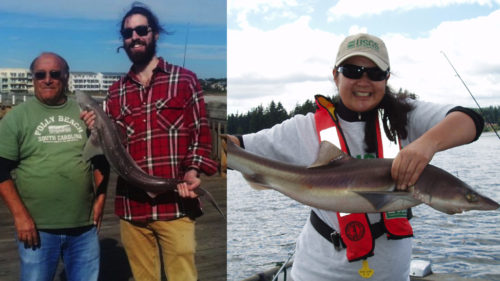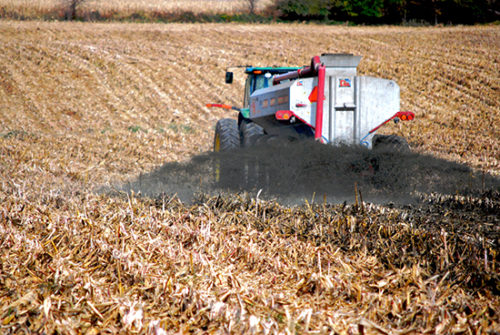Dogfish, farmland and toast – what’s culture got to do with them?
Alec Armstrong, David Miles ·Alec Armstrong, David Miles
Nature is part or product of culture, as our class discussed last week. When we say “nature” we invoke some mixture of values, knowledge, experiences, and stories to order our relationships with things in our universe. But how can culture be described and measured? This week we discussed two anthropological approaches to study how people think about nature: consensus analysis and cultural modeling.
Consensus analysis tests for a shared pool of ideas that a group of people draw upon when thinking about something. Looking for this consensus requires data, and the approach is quantitative. It assumes that knowledge and values are distributed among people across space and through time and can be measured. The data are usually survey or interview responses about the domain of the phenomena in question – say, toasted bread. If consensus exists, people use a similar pool of ideas when they relate to anything concerning toast – How long does it take to make? Is it best to butter it? When should you eat it? Toast consensus means a group of people share the same basic toast knowledge, including things not addressed during data collection. If consensus exists, people will likely have a common framework for judging whether someone who puts jam on toast is making a mistake.

We discussed an example of this approach, a study of spiny dogfish knowledge among scientists and fishers in Washington state (Miller et al., 2009). The study tested for consensus within each group and across groups. Every subject was given the same set of statements about dogfish to be judged as true or false. The accuracy of their answers relative to an external authority did not matter. In fact each question taken in isolation would not matter. Consensus depends on people responding similarly across the entire set of questions.

The approach uses factor analysis for inference. Since we can’t directly measure every possible belief related to some phenomenon, we ask questions about the hypothesized beliefs. The similarity between every pair of respondents’ answer sets is described mathematically, then all of these similarities are thrown into a matrix which is decomposed into factors that each explain a share of the variance among the correlations. If the factor explaining the most variance is sufficiently more important than the next factor, we infer consensus. Factors are abstractions – we want one unseen variable that drives the patterns of similarity in our data. Consensus just means there is mathematical evidence for a very strong thread running through our pool of responses. In the study, fishers and scientists responded similarly to 26 out of 29 questions. Their answers were not identical – of 23 respondents, 22 agreed dogfish are predators while only 18 agreed that dogfish are beautiful. Patterns of similarity across questions are the important thing.
This point initially troubled our class. We took our own survey about various controversial environmental issues. Many of us thought consensus could be evaluated for each question independently – thinking, for example, the class might show consensus on climate change risk while having split opinions and no consensus on nuclear power desirability by measuring responses to one question about each. But consensus analysis does not describe agreement about isolated questions. Consensus analysis instead uses survey questions to determine whether people share underlying knowledge.
We then moved to another tool in the anthropologist’s box, cultural modeling of the environment. Dr. Michael Paolisso described this to us as (to paraphrase) what you have to know in order to say what you said about something. It asks what mental models people use when articulating and interpreting natural phenomena. This approach relies on data, but is more qualitative than consensus analysis.

The example we discussed used interviews with several farmers to model land conservation. The goal of the study was to offer a model of how farmers organize the information and values relevant to land conservation. This model wasn’t comprehensive or mathematical, but instead articulated prerequisite, sometimes unspoken, beliefs or ideas called schema. Schema are the components necessary to coherently organize the farmers’ responses. An example from the paper: All land has a best use, so conserved land should incorporate this best use, whether that is cultivation, grazing, leaving forests alone, or building houses on it. Or: Farmers define preservation as ensuring land is put to its best use, while conservation is improving soil (and other) resources during and through their proper use. While explicit statements of these schema could be found in some interviews, they only really emerged after analyzing all the interview data. Further details of their systematic approach can be found in the article.

These methods have similar goals, but important differences exist between them. Consensus analysis measures the knowledge, values, and beliefs distributed among groups of people. Is this the nature of knowledge – something quantifiable, a variable that can be compared between two people? This approach requires it. The second cultural modeling approach is also trying to identify knowledge, values, or beliefs a group draws on to make meaning, but distills the data to reveal and name the underlying bedrock of shared truths. Is our knowledge a collection of signs springing from unspoken bonds of culture, subject to interpretation? Neither approach needs to be judged correct or true. Each is a model – a simplification used to make a complex phenomenon easier to understand, which we then hope can illuminate phenomena beyond the data used to build it.

Models can help us make sense of complex phenomena. Credit: jcpag2012
Why are these models important? Last week we discussed nature and culture, but from a bird’s eye view. This week we discussed how certain groups of people relate to specific natural phenomena and environments. Such insights may be valuable for anyone working in coupled human and natural systems. For example, a conservation biologist working to improve biodiversity in the rural landscape of Paolisso et al. may benefit from knowing how people are likely to view and use ecosystems targeted for their habitat value. The planner trying to secure legal protections for those ecosystems needs to know how to communicate with farmers if they want a cooperative conservation effort. And the farmers themselves may be able to use the model to better articulate their conservation (or preservation) goals and values to politicians. Most of us in the class are engaged in environmental research of some kind, and may benefit from thinking about the different ways people (including ourselves) see and relate to our research subjects.
References:
Miller, M.L., Lowe, A.T., & Galluci, V.G. (2009). Cultural consensus of fishermen’s and scientists’ knowledge of spiny dogfish in Puget Sound: a first step toward policy. In V.F. Galluci, G.A. McFarlane, and G.G. Bargmann, Biology and management of dogfish sharks (pp. 401-409). Bethesda, MD: American Fisheries Society.
Paolisso, M., Weeks, P., & Packard, J. (2013). A cultural model of farmer land conservation. Human Organization, 72(1), 12-22.
Next Post > Marching for Science in Washington, D.C.
Comments
-
Natalie Yee 9 years ago
Great insight! I love the toast comparison because it really ties in what we were discussing in class. Like Suzi, I've also taken a class that had a section focused on how religion shapes our perception of the natural world. We discussed the difference between domination and dominionship, if humans are an integrated element of the environment or if we are separate, etc. I saw those perspectives come back up in the readings with the farmers.
The discussion of cultural consensus analysis was very helpful in fully understanding the viewpoints of the respondents. I hope I will be able to go further into this concept because I think it will help me with my thesis.
-
W.Cruz 9 years ago
Good job! I enjoyed your description of the class! I really like the Miller et al., 2009 paper. The cultural consensus analysis seems unbias and follows the accumulated knowledge. At the end of the paper scientist and fisherman gain new knowledge. I think the cultural consensus analysis could be a format to follow in management meetings. Also, it is a way to take out our management glasses and see the environment like fishermen do and understand their points of view.
-
David Miles 9 years ago
One subject I really wanted to touch on in the class was the religious aspect of the eastern shore farmers' cultural model and what role it played in developing it. Unfortunately, we din't get the chance to explore that too much. The link Alec provided, the interfaith partners for the Chesapeake, was very interesting. I think religion is a major contributor to the cultural model of many rural landowners. Conservationist are partnering with churches to give a religious view of protecting the natural world in a way to incorporate rural residents into the environmental mindset. I think this will be a very important pathway to preserving and conserving lands in the US moving forward.
-
Kelly Hondula 9 years ago
This blog does a great summarizing our discussion and providing some nice insight for clarifying the issues it took us a while to understand as a class. I especially like the analogies to toast, and the image of the model of the solar system. These ideas and conceptual frameworks are so familiar to us that they become part of the tacit knowledge we use in describing really complex phenomena. Recognizing the possibility that others might have different conceptual schemas can definitely help facilitate conversation. Nice job Alec!
-
Suzi Spitzer 9 years ago
Nice blog! In class we very briefly discussed how religion can come into play with conservation and preservation. This discussion reminded me of an awesome class that I took in college, which was focused on topics in sustainability. The class was co-taught by four professors, similar to our class, who shared their expertise in the fields of environmental science, history, business and economics, and theology. The theology professor was a Catholic priest (I went to Notre Dame) and many of his lectures drew from Catholic social teaching and various papal documents, most which emphasized the value of stewardship. In a nutshell, the message was that the natural world is a divine creation that has been gifted and entrusted to humans. We are called to care for it and use it responsibly—not doing so is a show of disrespect for the Creator. Many other religions also have a specific view of the environment and a moral code for how humans should interact with it. When working with communities or communicating environmental science to people, we must understand that religion can contribute to or even define how people see their environment and then use this knowledge of spiritual and/or moral teachings to better understand the diverse relationships that different people have with the natural world.
-
Michael Paolisso 9 years ago
Alec,
I think you did an excellent job of clearly presenting the two approaches of cultural consensus and cultural models. I think the toast example is great. I can see people preparing and eating toast and imagining consensus underneath about what is toast and how it should be prepared and eaten, but that base of knowledge could not be named, unless one tried to do a cultural model of toast, which is possible. You make the key point: consensus does not mean agreement on any individual question, but that we suspect people are drawing upon a similar system or domain of cultural knowledge when they think about and eat toast. For the cultural model discussion, I would only add that a little discussion about the structure or content of the underlying cultural knowledge: schemas. If we bring in schemas, it is a first step to some possible connections with neuroscience. Overall, very good. Hope you use these approaches some day.
Michael -
Krystal Yhap 9 years ago
Great Blog Alec! I think I have a better understanding of the difference between cultural consensus analysis and cultural model after reading this and hearing Michael describe it in further detail in class last week. I like the metaphor of the toast, it made understanding the general concept behind cultural consensus analysis more easily understood. I read a paper recently where cultural models of water quality and water management in Phoenix Arizona were examined and termed "ethnohydrology". The paper sought to examine the water culture of urban residents in Phoenix Arizona and cultural consensus analysis was used. Water policy and management options in Phoenix are constrained by the public's knowledge, values, and opinions so doing this type of research has major implications for water management, sustainability, and planning. I'll actually be referring to this paper in my proposal and I found the topic very interesting since I interested in/ am from an urban water resource management background. If you are interested in reading it I'll post the link below:
http://www.diva-portal.org/smash/record.jsf?pid=diva2%3A472111&dswid=311
-
Rachel E 9 years ago
This class was definitely eye opening. I initially I was confused about what the cultural consensus was, and now I am more clear. In fact, after clarifying the meaning of the term I realized that it would be an interesting tool to apply in my study area. Just like the dog fish, there are a lot of different views of eagles in Michigan. Since their return/ recovery, people have different opinions. Some people find them a nuisance or even a pest when they scavenge for small mammals or livestock. There are stories of eagles taking small dogs and cats. One family even asked me to climb to a nest that we knew was empty to look for the collar that belonged to their dog, Sparkey, who's footprints in the snow mysteriously stopped on winter day and was never found again. :[
There is a story that I heard all throughout the upper penninsula that there was an eagles nest that blown over that had 300 (or 500, depending on who you're talking to) small pet collars in it.
There are people that feel so strongly that they will purposely shoot eagles (even though this is a federal offence).
Meanwhile, there are people who are absolutely overjoyed by the eagle recovery.It would be interesting to do cultural consensus analysis on the population of people in Michigan to see if they have a similar foundation of knowledge or act in similar patterns and to see what factors influence these decisions.
Great Blog! I loved the images.
-
V Leitold 9 years ago
What I find particularly interesting in the discussion about “how certain groups of people relate to specific natural phenomena and environments” is how different cultures focus/rely more heavily on either the explicit/verbal or the tacit/unspoken mode of knowledge. To illustrate this, I wanted to share the following passage from my recent reading (for a drawing class…):
“Thomas Gladwin, an anthropologist, contrasted the ways that a European and a native Trukese sailor navigated small boats between tiny islands in the vast Pacific Ocean.
Before setting sail, the European begins with a plan that can be written in terms of directions, degrees of longitude and latitude, estimated time of arrival at separate points on the journey. Once the plan is conceived and completed, the sailor has only to carry out each step consecutively, one after another, to be assured of arriving on time at the planned destination. The sailor uses all available tools, such as a compass, a sextant, a map, etc., and if asked, can describe exactly how he got where he was going.
In contrast, the native Trukese sailor starts his voyage by imaging the position of his destination relative to the position of other islands. As he sails along, he constantly adjusts his direction according to his awareness of his position thus far. His decisions are improvised continually by checking relative positions of landmarks, sun, wind direction, etc. He navigates with reference to where he started, where he is going, and the space between his destination and the point where he is at the moment. If asked how he navigates so well without instruments or a written plan, he cannot possibly put it into words. This is not because the Trukese are unaccustomed to describing things in words, but rather because the process is too complex and fluid to put into words.” (–J. A. Paredes and M.J. Hepburn "The Split-Brain and the Culture-Cognition Paradox" 1976, cited in “Drawing on the Right Side of the Brain” by Betty Edwards) -
Killian F 9 years ago
Great blog post! It really helped to solidify my understanding of cultural consensus. I also really loved Rachel’s comment on the differing views on eagles in Michigan. Do you find evidence that the eagles are taking people’s pets in such large quantities, or even at all? I agree that it would be interesting to do consensus analysis on people in Michigan to understand their views on eagles. Creating management plans for eagles that take into account both people that think they are a nuisance and people that really enjoy seeing the eagle recovery could prove challenging if people have different knowledge foundations and very different viewpoints. The first step for this and for many other issues where there is a clash of viewpoints is to understand why people think the way they do and the basis for their knowledge.
-
Rebecca Wenker 9 years ago
Good job Alec! I agree with Krystal, you were really able to drive home the differences between the culture consensus analysis and the cultural model (and explain the methods themselves)in a very clear way. One thing that really struck me from this class was how a subtle discrepancy between groups on the meaning of conservation and their subsequent beliefs on how to "conserve" land could really alter or hinder a collaborative effort. Understanding and resolving these discrepancies is essential if such an effort is to succeed.
This also had me thinking about my experiences in Belize, where the jaguar conservation effort has been ongoing since the 1980s. One of the biggest issues has been the local viewpoint that jaguars have been historically hunted, are overall negatively viewed by the local (due to things like predation, etc.). I found a paper that looks into the attitudes towards jaguars, human-jaguar conflicts, and potential community-based jaguar conservation in two Maya villages in the Toledo District in southern Belize. The investigators employ some of the techniques we talked about in class, like using questions and indirect methods to determine the perception of jaguars by the local Maya people. Take a look if you're interested!
http://www.conservationandsociety.org/article.asp?issn=0972-4923;year=2016;volume=14;issue=1;spage=13;epage=20;aulast=Steinberg
-
Noelle O. 9 years ago
I think Alec did a great job breaking down the components of consensus modeling and cultural modeling. I had previously used principle components analyses (https://en.wikipedia.org/wiki/Principal_component_analysis) for fish-related data, I had never thought to apply this kind of analysis to learn more about sociological questions (i.e. attitudes toward dogfish management)-Very cool! This topic definitely made me think about how increased collaboration between natural resource scientists, social scientists, and natural resource management can be highly productive.
It is extremely important to understand the varying attitudes toward certain management measures, particularly when issues are more "charged" like in the case of bald eagles and jaguars like Rachel and Rebecca have mentioned.